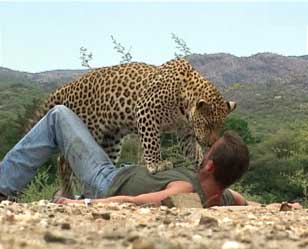"If you hear the scream of a panther
Don't anther."
Ogden Nash
Karen Pryor comments:
Reintroducing wild animals to the natural environment is always a tricky business. Recently we've all seen the not-very-successful effort involving freeing the "Free Willy" killer whale. Basically the whale arranged things so that for the rest of his life he continued to be fed and entertained by humans, while living in the open sea.
I've been witness to or involved in several reintroductions, ranging from Scott Lindbergh's successful re-establishment of a group of captive howler monkeys in a nature reserve in Brazil, to well planned, badly planned, and unplanned releases of various dolphins into the ocean. Will the animal survive? Can we keep track of it? How will it react to people once it is living on its own?
Here is a remarkable story of a leopard, a desert, and a clicker trainer. It may suggest a brand-new tool for track and study animals in the wild-and the National Geographic was there to film the whole thing.
Daniel J. Radzeij works at the Wildlife Rescue center at the Lindbergh Nature Reserve in South Africa. Here is his story.
"More then a year ago we released a captive bred and hand raised leopard in a large nature reserve in Namibia. I have raised the animal and worked intensively with the clicker with him. The animal was target trained, would lie down and stay and performed all sorts of little 'tricks'. The leopard then was radio collared and released into the reserve in August 2002 at the age of three and then did not have any human contact whatsoever. He could hunt perfectly by himself."
"We and the National Geographic asked ourselves: How would this animal now react to me who raised him and who conditioned him? Would he recognize me at all? Would he simply avoid me, or even show aggressive behavior, since he had not had any human contact for almost 1 ½ years?"
"We decided to find out and film the sequence. After the location of the animal was pinpointed in the 50,000 hectare reserve I set off equipped with a clicker, the target and meat as primary [reinforcer]. My veterinarian and the NatGeo cameraman and director followed me at some distance. My vet had the tracking device and gave me directional advice."

"After approximately an hour's walk the vet said that the animal must be very close although we could not spot him. I called the leopard and he came running at me almost immediately. It was unbelievable. The leopard greeted me as if I was an old friend and showed no avoidance or aggressive behavior whatsoever. The behaviors previously established had not faded away at all. The animal would lie down on cue and stay until reinforced and clearly responded to the clicker. Everybody was thrilled. It was as if I had been away only for a day or two and all this in a wild open and unprotected environment (some of you might call this crazy)."
"We have raised, trained and released several animals in the past and NatGeo now wants to track down every single one of them and see if they react similarly. Colleagues have suggested that the answer to such questions might be found in the field of applied ethology. I tend to disagree. Purely observing wild animals interact with their own kind in nature can lead to wrong conclusions. Ethologists and ecologists call the leopard a solitary animal which prefers to stay on its own. But do they really see all these little encounters adult leopards have in nature? Ecologists and ethologists are only able to observe a very tiny part in a leopard day (or night). They might lay out bait which is perhaps the best chance to see these elusive animals in the wild. If then all of a sudden two cats appear and start to fight over the food (which is perfectly normal), the scientists may conclude that leopards are solitary and fight when they bump into each other. However, the same two cats might have spent already the whole day perfectly peacefully in each other's company without being observed."
"As Karen Pryor once said:
I subscribe to that."
Daniel J. Radzeij
Animal Ambassadors
Wildlife Rescue Centre
Lindbergh Nature Reserve
Womeransstad, Northwest Province
South Africa


Post new comment